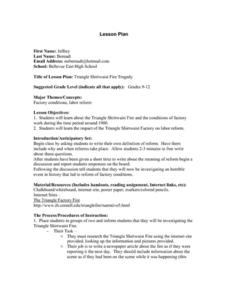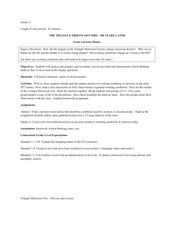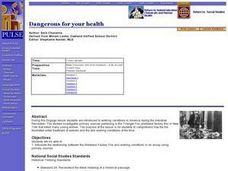Curated OER
Triangle Shirtwaist Fire Tragedy
Students research the Triangle Shirtwaist Fire. In this labor reform lesson, students research the fire and write a newspaper article report from the perspective of the time. Students evaluate the perspective of the workers and create...
National Woman's History Museum
The Triangle Shirtwaist Fire
On March 25, 1911, 146 garment workers died in the Triangle Shirtwaist Factory fire. Class members use primary source documents to research the tragedy and how it lead to the creation of labor unions and new labor laws. As an exit...
Curated OER
The Triangle Shirtwaist Fire: 100 Years Later
Eleventh graders examine the impact of the Triangle Shirtwaist Fire. In this American History instructional activity, 11th graders analyze various sources. Students create a cartoon representing the impact of this fire on the United...
Curated OER
Triangle Fire and Labor Movement
Tenth graders, in groups, explore the garment industry before, during, and after the Triangle Shirtwaist Fire to learn about the Labor Movement, unions, and some of the people who impacted working conditions for both adults and children...
National First Ladies' Library
Fire! The Triangle Shirtwaist Factory Trial and It's Aftermath
Middle schoolers research, examine and are provided the opportunity to re-enact one of the most exciting trials of the 20th century, The Triangle Shirtwaist Factory Trial. They research the history of the trial and then divide into...
Center for History Education
The Triangle Shirtwaist Factory Fire: Is Anyone to be Punished for This?
The stories of bodies falling to the pavement and girls dying in their seats echo to the present day. The New York City Triangle Shirtwaist Factory fire—which killed 147 people, mostly young women and girls—galvanized the labor movement...
University of Wisconsin
Why Did the Triangle Fire Occur?
An investigation of the 1911 New York City Triangle Shirtwaist Factory fire leads class members to examine primary and secondary source materials related to the event and apply what they learn about the working conditions at the time to...
Curated OER
Progressives Perspectives
Eleventh graders consider the case for Progressive politics. In this Progressive Era lesson, 11th graders read excerpts from The Jungle as well as articles about the Triangle Shirtwaist Factory fire. Students also analyze images from the...
National Woman's History Museum
Country to City
After reading a series of primary source documents, groups compare the lives of and opportunities available to rural and urban women in the 19th century to rural and urban life in the 21st century. As an exit ticket, individuals craft a...
Curated OER
Dangerous for your health
High schoolers articulate the relationship between the Shirtwaist Factory Fire and working conditions in an essay using primary sources. They are introduced to working conditions in America during the Industrial Revolution.
Curated OER
The Industrial Age in America: Sweatshops, Steel Mills, and Factories
Students investigate the working conditions during the Age of Industrialization. They research how workers reacted to the conditions and discuss the results of labor movement.
Curated OER
Glided Age
Eleventh graders will participate to brainstorm on the overhead, characteristics of an "irresponsible" adult and 5 of a "responsible" one? How do these differ if we apply these to businesses? Working in partners--Create a Code of Ethics...
Curated OER
Progressivism
Students interpret historical evidence presented in primary and secondary resources. In this Progressive Era lesson, students examine the concerns of American citizens during the era and compare them to...
Curated OER
Progressivism: What's the Problem?
Eighth graders interpret historical evidence presented in primary and secondary resources. In this Progressive Era lesson, students examine the goals and accomplishments of the Populist Party.















